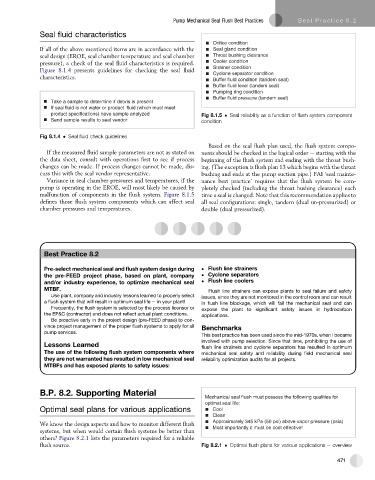Page 500 - Subyek Teknik Mesin - Forsthoffers Best Practice Handbook for Rotating Machinery by William E Forsthoffer
P. 500
Pump Mechanical Seal Flush Best Practices Be st Practice 8.2
Seal fluid characteristics
Orifice condition
If all of the above mentioned items are in accordance with the Seal gland condition
seal design (EROE, seal chamber temperature and seal chamber Throat bushing clearance
pressure), a check of the seal fluid characteristics is required. Cooler condition
Strainer condition
Figure 8.1.4 presents guidelines for checking the seal fluid
Cyclone separator condition
characteristics.
Buffer fluid condition (tandem seal)
Buffer fluid level (tandem seal)
Pumping ring condition
Buffer fluid pressure (tandem seal)
Take a sample to determine if debris is present
If seal fluid is not water or product fluid (which must meet
product specifications) have sample analyzed Fig 8.1.5 Seal reliability as a function of flush system component
Send sample results to seal vendor condition
Fig 8.1.4 Seal fluid check guidelines
Based on the seal flush plan used, the flush system compo-
If the measured fluid sample parameters are not as stated on nents should be checked in the logical order e starting with the
the data sheet, consult with operations first to see if process beginning of the flush system and ending with the throat bush-
changes can be made. If process changes cannot be made, dis- ing. (The exception is flush plan 13 which begins with the throat
cuss this with the seal vendor representative. bushing and ends at the pump suction pipe.) FAI ‘seal mainte-
Variance in seal chamber pressures and temperatures, if the nance best practice’ requires that the flush system be com-
pump is operating in the EROE, will most likely be caused by pletely checked (including the throat bushing clearance) each
malfunction of components in the flush system. Figure 8.1.5 time a seal is changed. Note that this recommendation applies to
defines those flush system components which can affect seal all seal configurations: single, tandem (dual un-pressurized) or
chamber pressures and temperatures. double (dual pressurized).
Best Practice 8.2
Pre-select mechanical seal and flush system design during Flush line strainers
the pre-FEED project phase, based on plant, company Cyclone separators
and/or industry experience, to optimize mechanical seal Flush line coolers
MTBF. Flush line strainers can expose plants to seal failure and safety
Use plant, company and industry lessons learned to properly select issues, since they are not monitored in the control room and can result
a flush system that will result in optimum seal life e in your plant! in flush line blockage, which will fail the mechanical seal and can
Frequently, the flush system is selected by the process licensor or expose the plant to significant safety issues in hydrocarbon
the EP&C (contractor) and does not reflect actual plant conditions. applications.
Be proactive early in the project design (pre-FEED phase) to con-
vince project management of the proper flush systems to apply for all Benchmarks
pump services.
This best practice has been used since the mid-1970s, when I became
involved with pump selection. Since that time, prohibiting the use of
Lessons Learned flush line strainers and cyclone separators has resulted in optimum
The use of the following flush system components where mechanical seal safety and reliability during field mechanical seal
they are not warranted has resulted in low mechanical seal reliability optimization audits for all projects.
MTBFs and has exposed plants to safety issues:
B.P. 8.2. Supporting Material
Mechanical seal flush must possess the following qualities for
optimal seal life:
Optimal seal plans for various applications Cool
Clean
Approximately 345 kPa (50 psi) above vapor pressure (psia)
We know the design aspects and how to monitor different flush
Most importantly it must be cost effective!
systems, but when would certain flush systems be better than
others? Figure 8.2.1 lists the parameters required for a reliable
flush source. Fig 8.2.1 Optimal flush plans for various applications e overview
471

